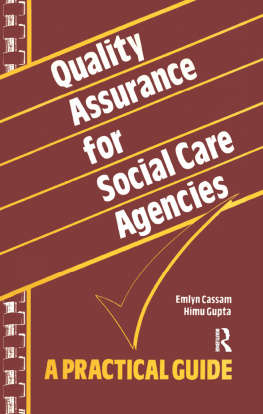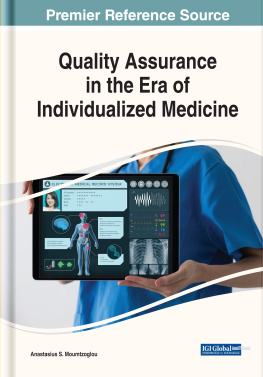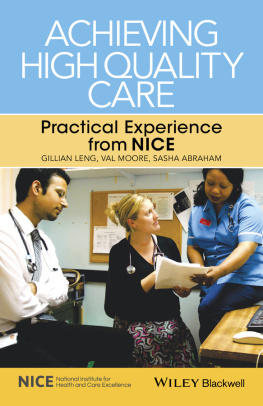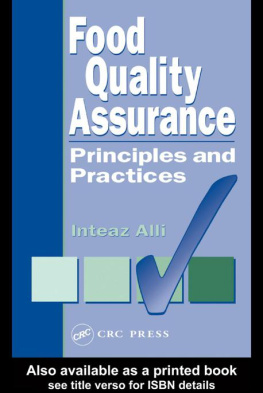Quality assurance for social care agencies
A practical guide
Quality assurance for social care agencies
A practical guide
By
Emlyn Cassam and Himu Gupta
First published in 1992 by Longman Group UK Ltd.
Published 2017 by Routledge
2 Park Square, Milton Park, Abingdon, Oxon OX14 4RN
711 Third Avenue, New York, NY 10017, USA
Routledge is an imprint of the Taylor & Francis Group, an informa business
Copyright Taylor & Francis 1992
All rights reserved. No part of this book may be reprinted or reproduced or utilised in any form or by any electronic, mechanical, or other means, now known or hereafter invented, including photocopying and recording, or in any information storage or retrieval system, without permission in writing from the publishers.
Notice:
Product or corporate names may be trademarks or registered trademarks, and are used only for identification and explanation without intent to infringe.
A catalogue record for this book is available from the British Library.
ISBN 13: 978-0-582-08944-0 (pbk)
Typesetting by: Typestyles (London) Limited, Harlow, Essex
Contents
First and foremost, our appreciation must go to the Councillors and staff of Norfolk County Council, without whose vision and dedication much of this countrys thinking about quality assurance would have been diminished. Our thanks too to David Wright, Norfolks Director of Social Services, for his permission to quote from the Departments documents.
Our admiration goes to Clive Bone for his clear thoughts and his encouragement.
Our thanks to Anne Parker, CBE and Hugh Dunnachie of the Royal County of Berkshire, some of whose thinking we have unashamedly incorporated in this book.
The past two decades have seen significant changes for the better in the management of quality within the UK, with continuous improvement throughout the period.
A little over 20 years ago, we had no national standards for quality systems and the responsibility for assuring the quality of products and services lay, to an undesirable extent, with the customer. Today, we have the situation where a very large number of companies and organisations of all kinds, in both the private and public sector, have introduced, or are introducing, quality systems which conform with national and international standards (BS5750/IS9000). Indeed, UK achievements in the assessment and certification, with national registration, of such companies and organisations, are probably unequalled anywhere else in the world. Quality assurance is now seen as a partnership between supplier and customer, with much greater reliance being placed on the suppliers for assuring the quality of their products and services.
This demonstrable improvement in UK quality managment did not occur spontaneously, however, it is the result of a great deal of dedicated and planned work and promotional effort by a considerable number of organisations and a great many people, from Government as the principal promoter, to the companies and organisations which introduced the quality systems. Principal contributors also include BSI, Certification Bodies, Local Authorities, NACCB, Professional Institutions, Universities and Colleges, Public Purchasing Authorities, Quality Consultants, Trade Associations and The British Quality Association (BQA) which has, as a principal objective, the promotion of best practices in quality management throughout the UK. The BQAs promotional role is executed largely through its Sector Quality Committees which, significantly, operate not only for the various industrial and commercial sectors, but also currently for Education and Training, Local Authorities and Social Care Agencies, the Sector Quality Committee for this last sector, having been chaired since its formation, by the co-author of this book, Mr Himu Gupta.
Much has been achieved but much improvement in UK quality management is still yet possible and necessary. The BQA and other organisations have therefore for several years now additionally been promoting Total Quality Management (TQM); this being a corporate management philosophy in which the accomplishment of quality is achieved by the personal involvement and accountability of all employees in an organisation, devoted to a continuous improvement process and committed to meeting customer needs.
As in TQM, quality promotion is aimed at a continuous improvement process and the authors of this book have made a welcome contribution to quality promotion in the important field of Social Care Agencies.
Bob Lonsdale CBE
Immediate past Chairman
BQA Board of Management
The aims of this book are to be practical, readable and useful. Students who wish to delve into the arcana of theoretical concepts would be better advised to search elsewhere. During the last 5 years, the authors have devised and introduced a system of quality assurance into one of the largest social services departments in the country. Here, they describe how they did it, setting out the pitfalls and rewards, the successes and surprises.
The book will be of interest to anyone who is thinking of promoting the concepts of quality either in large organisations or in smaller teams and units. The impetus towards producing a quality outcome may be generated by councillors, managers, staff, consumers, voluntary bodies, professional associations, trade unions. All may benefit from reading this practical description of what works and what does not.
Of course, no one ever admits to having no interest in quality. Everybody would say that they intend to provide a good quality service, and are often affronted when obvious failures are starkly brought to their attention often accompanied by hurtful publicity. Councils whose youngsters complain about intolerant or irrelevant regimes in their childrens homes; proprietors of residential homes whose insensitivity denies dignity to their residents; staff whose restrictive practices force consumers into lifestyles even less flexible than penal institutions; voluntary organisation who so patronise their recipients that they have fewer rights than children; workers whose arrogance precludes their listening to what their clients are saying; politicians who promise Valhalla and deliver purgatory; all would probably claim that they are aiming at quality and doing the best they can. And when things do go wrong, always the fault lies with resources or incompetent bureaucrats or the profit motive or the Government or training always something beyond their control. This book insists that quality must be the responsibility of everyone, and sets out what you can do to achieve it.
Aiming for quality in the work of social care agencies is not new. Achieving it, however, is somewhat rare. Practical instructions on how to tackle the task are few and uncoordinated. Like the pot of gold at the end of the rainbow, we all cherish the ambition of reaching it, but the precise route is difficult to find. Exhortations abound and there is no shortage of Government strictures placing the full responsibility on local authorities for securing good standards of care.
In managing the mixed economy of care, ensuring quality will be vital. No agency has a monopoly of virtue on quality. So far as local authorities are concerned the recent SSI report on the management of local authority homes for the elderly made that abundantly clear. We look to you to ensure that the care provided is not simply the cheapest, nor the most convenient to supply, nor a ratification of the way things have always been done, but the package that best meets the clients need. To define good quality is not always easy but I urge you to begin listening to your clients.











